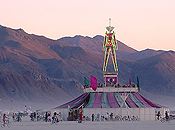City Design
Black Rock Citys designers reclaimed the teams former appellation – City Design – in 2005, and will no longer be known as the Planning Department. Tasks include overall city planning and design, design of official structures (including each years theme-related structure supporting the Man), as well as production of illustrations and other graphics.
Rezoning
At the 2004 staff retreat, designers proposed an experiment in social engineering. The Burning Man community has traditionally been highly cohesive, holding together through the roughest times. Over the last few years, the burgeoning city has experienced growing dissension, as evidenced in newspaper accounts, blogs, staff disruptions, splinter groups, etc. Some reasoned that this effect might well be traced to alienation due to loss of a human scale in the population size, as well as the tight segregation of the theme camps from remaining participants.
City designers, responding to staff and participant feedback, recommended that the thick band of theme camps, which have historically occupied the prime “inside” rings of the city, be distributed farther back into its heart. Further changes proposed included breaking down the monolithic city into sections – “neighborhoods” similar in size to those of 5 years ago, before such disharmony was evident. These two corrections were unified into one proposed scheme by distributing theme camps along two radial roads so as to divide the city into three main zones. Designers worked with staff to assure that the final city map addressed all concerns. The concept was approved and implemented, and although it is too early to assess the long-term results, to date no further evidence of significant disaffection has been noted, and much feedback reports positive effects.
Planning
 Members of the team participated with pleasure in the National City Planners Association convention at Moscone Center in San Francisco during 2005. Together with a board member from Black Rock City LLC and a representative of the Bureau of Land Management (BLM), the group presented a seminar tracing the creation and development of our fair city. A visual history traced events from the first desert camp through creation of the first Black Rock City plan in 1997, and following up to 2005 event. A great many rapt and envious city planners attended the session. Burning Man has created one of the few cities planned and built in this millennium, and the team could boast of the recent rezoning as well – something dear to every city planner’s heart.
Members of the team participated with pleasure in the National City Planners Association convention at Moscone Center in San Francisco during 2005. Together with a board member from Black Rock City LLC and a representative of the Bureau of Land Management (BLM), the group presented a seminar tracing the creation and development of our fair city. A visual history traced events from the first desert camp through creation of the first Black Rock City plan in 1997, and following up to 2005 event. A great many rapt and envious city planners attended the session. Burning Man has created one of the few cities planned and built in this millennium, and the team could boast of the recent rezoning as well – something dear to every city planner’s heart.
Structure and Design
 The team re-evaluated the 2000 creation of the 40,000+ square foot Center Camp Café structure, and it continues to stand the test of time. The Man’s Funhouse was a challenging new project for 2005. Three stories of public deck area surrounded by an intricate maze all supported the many participants who gathered there and the Man itself – but they were also needed the ability to spin the sculpture about. This requirement was no mean task, considering the Man’s weight of 3,000 pounds and height of 40 feet off the ground, along with potential winds of 70 MPH. With the help and collaboration from a team of dozens of people, the goal of the Man spinning was accomplished.
The team re-evaluated the 2000 creation of the 40,000+ square foot Center Camp Café structure, and it continues to stand the test of time. The Man’s Funhouse was a challenging new project for 2005. Three stories of public deck area surrounded by an intricate maze all supported the many participants who gathered there and the Man itself – but they were also needed the ability to spin the sculpture about. This requirement was no mean task, considering the Man’s weight of 3,000 pounds and height of 40 feet off the ground, along with potential winds of 70 MPH. With the help and collaboration from a team of dozens of people, the goal of the Man spinning was accomplished.
Graphics
The City Design team also represents the visual images of architectural and civic designs in Burning Man publications and on the website. Once the design is established, this imagery is largely accomplished through handwork in Photoshop, but some work uses specialized 3D programs, as well. Plans and graphics serve for many other organizational needs, as well, including permit applications, other newsletters, the calendar, etc.
City Location
For 2006, the design team is proposing once again that the city be somewhat relocated. The playa surface at the southwestern edge of Black Rock City’s pentagon is quite soft. This thin-crusted material is difficult to negotiate, and it breaks easily into a powder, creating a prime source of dust clouds. The dome of the playa surface rises toward the northeast, producing a thicker and harder crust. The organization is looking at ways to solve this problem.
Submitted by,
Rod Garrett, City Designer

